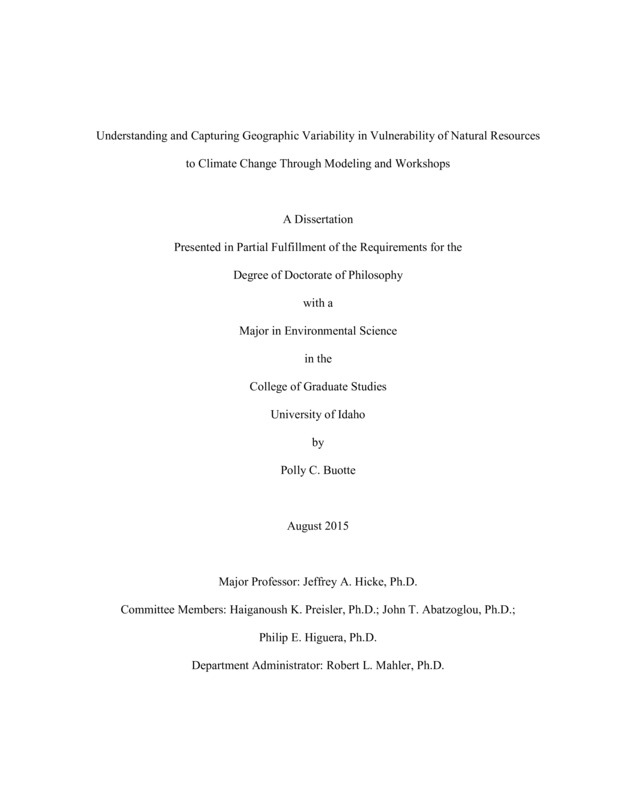Understanding and Capturing Geographic Variability in Vulnerability of Natural Resources to Climate Change Through Modeling and Workshops
Buotte, Polly Catherine. (2015). Understanding and Capturing Geographic Variability in Vulnerability of Natural Resources to Climate Change Through Modeling and Workshops. Theses and Dissertations Collection, University of Idaho Library Digital Collections. https://www.lib.uidaho.edu/digital/etd/items/buotte_idaho_0089e_10688.html
- Title:
- Understanding and Capturing Geographic Variability in Vulnerability of Natural Resources to Climate Change Through Modeling and Workshops
- Author:
- Buotte, Polly Catherine
- Date:
- 2015
- Keywords:
- climate change mountain pine beetles vulnerability assessments whitebrak pine
- Program:
- Environmental Science
- Subject Category:
- Climate change; Ecology; Environmental science
- Abstract:
-
Climate patterns exert a strong influence on many ecological systems. Understanding how a changing climate will affect our natural systems is a necessary prerequisite for developing appropriate management strategies that will enable these systems to persist into the future. The mountain pine beetle (Dendroctonus ponderosae Hopkins) is a native species that is strongly influenced by climate and recently, unprecedented outbreaks have occurred in Canada and at high elevations in the U.S. I investigated weather influences on the recent beetle outbreak in whitebark pine forests in four geographic regions of the western U. S. I used a generalized additive logistic regression model of the presence of whitebark pine mortality from mountain pine beetles to: 1) understand weather effects on the recent outbreaks, 2) diagnose the relative importance of weather conditions prior to and during the recent outbreaks, and 3) estimate future weather suitability for whitebark pine mortality from mountain pine beetles. Whitebark pine mortality increased with increasing winter minimum temperature in all regions, but the magnitude of the effect at a given temperature was different. The effects of seasonal (September-November and April-August) temperatures and summer precipitation were different across regions at the outer ranges of observed temperature and precipitation. In all regions the recent outbreaks appeared to be initiated by warm winters. In some regions outbreaks coincided with low precipitation as well. These differences in weather influences led to differences in estimates of future weather suitability, even though there is a common pattern of increasing temperatures across regions, with future weather suitability increasing in two regions and declining in two regions. Statistical modeling is one way to assess geographic variability in climate change vulnerability. Conducting workshops to elicit expert opinion is another. I developed and tested a framework for capturing geographic variability in climate change vulnerability during a regional-scale vulnerability assessment. My revised framework is structured around pathways of climate influence on species or resources. This structure provides a means of capturing potential hypotheses of climate influence that can then be used to develop an adaptive monitoring program that is tailored to geographic regions but coordinated across administrative and ecological boundaries.
- Description:
- doctoral, Ph.D., Environmental Science -- University of Idaho - College of Graduate Studies, 2015
- Major Professor:
- Hicke, Jeffrey A
- Committee:
- Preisler, Haiganoush K; Abatzoglou, John T; Higuera, Philip E
- Defense Date:
- 2015
- Identifier:
- Buotte_idaho_0089E_10688
- Type:
- Text
- Format Original:
- Format:
- application/pdf
- Rights:
- In Copyright - Educational Use Permitted. For more information, please contact University of Idaho Library Special Collections and Archives Department at libspec@uidaho.edu.
- Standardized Rights:
- http://rightsstatements.org/vocab/InC-EDU/1.0/

